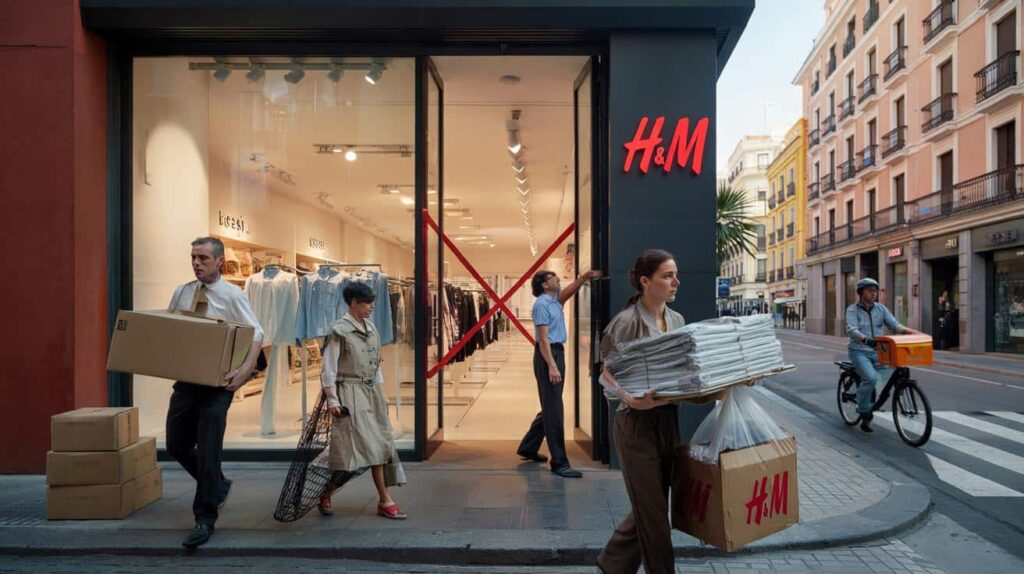The upcoming move takes place in close proximity.
H&M is set to reduce its store presence in Spain as it adapts its strategy for a more challenging market. This decision reflects significant insights into the future of fashion retail and the brand’s approach to safeguarding its profit margins while maintaining customer interest.
H&M to close 28 stores in Spain and cut 500 jobs
The company has announced a major restructuring plan in Spain for 2024–2025. It will close 28 stores, which is approximately 17% of its national network, and eliminate around 500 jobs. The brand attributes this decision to decreased foot traffic, increasing operational costs, and a stronger shift towards online shopping.
The 28 store closures in Spain account for about 17% of the total network, impacting 500 jobs. The retailer is transitioning to a more streamlined and robust network.
Management intends to focus on prime, high-traffic locations while investing in logistics, last-mile delivery, and enhanced online visibility. The message is straightforward: fewer stores, better quality stores, and a more efficient, interconnected e-commerce platform.
Intense competition is a significant factor in this transition. Emerging platforms like Shein and Temu attract younger consumers with extremely low prices and a rapid product release schedule. This trend creates challenges for traditional retailers, which have higher fixed costs and slower inventory turnover.
- Demand is shifting online faster than many lease agreements can expire.
- Competing platforms are driving down prices and accelerating trend cycles.
- Store labor and energy expenses are increasing while customer footfall declines.
- Consumers expect hassle-free returns, convenient pickup options, and quick shipping.
Why Spain is a focal point
Spain is a vital fashion market, but it also illustrates the new dynamics of retail. Tourist traffic can fluctuate significantly. Secondary shopping centers report inconsistent visitor numbers. Additionally, discount-oriented competitors are targeting budget-conscious consumers. In this context, H&M is prioritizing flagship locations and premium shopping centers, where the brand’s presence justifies the rental costs.
The brand maintains its presence where visibility and average purchase size are highest, while scaling back in areas where traffic cannot support a full store.
Anticipate a more concise list of store locations, larger and more engaging retail spaces, enhanced click-and-collect services, and more streamlined inventory. Backroom spaces will be reduced. Supply chains will become more efficient. Store employees will dedicate more time to styling and preparing online orders for shipment.
France takes a different approach
France presents a more moderate scenario. The store network decreased from 197 locations in 2023 to 169 in 2024, but the company emphasizes that the focus is on adaptation rather than a straightforward closure or expansion strategy. The emphasis is on renovations, omnichannel improvements, and an increased role for resale initiatives that align with the growing demand for sustainable fashion.
In France, the strategy emphasizes renovations, resale programs, and service enhancements instead of widespread closures.
Consumers may notice updated store layouts, clearer size offerings, and more flexible return policies. Where local stores close, the website and app will take on the burden with extended delivery options and pickup locations. Limited edition releases and co-branded collections will help maintain interest without overstocking.
What customers can expect
Retailers typically do not disappear from a market overnight; they adjust the distribution of their touchpoints. Spain will rely on a smaller number of strong stores and a more comprehensive online experience. France will maintain a wider presence but will modernize the operations of each location. For shoppers, this generally translates to improved inventory accuracy, faster order fulfillment, and fewer struggling small stores.
| Market | Current actions | Store footprint implications | Job impact | Changes for customers |
|---|---|---|---|---|
| Spain | 28 closures; network consolidation | Focus on prime, high-traffic locations | Approximately 500 jobs affected | Enhanced online services; larger flagship stores; more focused product assortments |
| France | Renovations; second-hand initiatives | Smaller footprint than 2023 but still extensive | Not disclosed | Improved omnichannel experience, returns, and curated selections |
A fashion industry under strain
H&M is not the only one facing challenges. Established brands are dealing with rising costs while digital competitors thrive on speed and affordability. Consumers are looking for value, but they also desire durable basics, fair return policies, and a commitment to sustainable production. Brands that successfully address all three can maintain pricing power and customer loyalty.
This pressure is reshaping operations. Merchandising timelines are becoming shorter. Data teams are forecasting demand at the SKU level. Stores are also functioning as micro-fulfillment centers. Marketing strategies are shifting from broad campaigns to targeted releases that sell out without significant discounts.
The next phase appears to be hybrid: fewer but higher-quality stores, alongside a faster, data-driven online platform that accounts for the majority of growth.
Key indicators to monitor in the coming year
Keep an eye on the pace of store closures in Spain and the size of the remaining network. Observe how quickly refurbished locations in France increase sales per square meter. Pay attention to fulfillment commitments: delivery speed, pickup convenience, and return costs provide valuable insights into where investments are being made.
- If clearance sales deepen, it indicates that inventory levels remain too high.
- If return costs increase, the company is likely trying to protect its profit margins.
- If capsule collections sell through more effectively, it suggests that curation and demand forecasting are working well.
Effects on employees, landlords, and local businesses
The 500 jobs at risk in Spain highlight a sensitive transition. Some positions may be transferred to nearby stores, logistics, or customer service roles. Others may be eliminated through severance packages or retraining programs. Unions will advocate for redeployment and training, particularly in last-mile and warehouse operations that are expanding due to the rise in online orders.
Landlords face a different set of challenges. Prime retail areas may quickly fill vacant spaces. Secondary locations may struggle to attract tenants. Expect shorter lease agreements, rent linked to turnover, and more co-tenancy clauses as fashion retailers seek flexibility in a rapidly evolving market.
Important information for consumers
Waves of store closures typically lead to phased markdowns. Initial weeks focus on selective discounts; later phases clear entire categories. If you are looking for value, keep an eye on basics and outerwear during the mid-sale period, when sizes are still available. For returns from closing stores, policies often shift to online or to the nearest operational location—check your receipts before making a purchase.
Beyond closures: what a “leaner network” truly entails
For a retailer like H&M, the objective is not solely to reduce costs. The aim is to enhance the productivity of every square meter and minimize stock shortages. A more concentrated network focuses demand, simplifies staffing, and accelerates the transition of trends from design to retail shelves. The online platform then accommodates the broader range of sizes and colors without requiring every store to stock them.
This model can also support sustainability goals. Fewer shipments to underperforming stores can reduce waste. Resale initiatives extend the lifespan of garments and attract price-sensitive customers without undermining new collections. If the brand maintains consistent quality, it can increase customer lifetime value even as the number of stores decreases.








